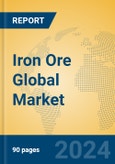Market Size and Growth Forecast
The iron ore market is anticipated to reach USD 115-125 billion by 2025, with a CAGR of 1%-2% through 2030, reflecting stable steel demand in emerging markets offset by declining growth in mature economies and surplus supply pressures.Regional Analysis
Asia Pacific, led by China, expects growth of 1.5%-2.5%, with China’s steel production driving imports, though trends show a shift toward scrap steel use. Oceania, primarily Australia, anticipates growth of 1%-2%, leveraging its export dominance to meet Asian demand. South America, notably Brazil, projects growth of 0.5%-1.5%, with Vale’s output supporting global supply. North America expects growth of 0.5%-1%, tied to infrastructure renewal, with minimal mining expansion. Europe anticipates growth of 0.5%-1.5%, reliant on imports for steelmaking.Application Analysis
- Steel Pipes: Projected at 1%-2%, driven by infrastructure and energy projects, with trends favoring corrosion-resistant alloys.
- Steel Rod and Wires: Expected at 0.5%-1.5%, used in construction, with steady demand.
- Steel Sheets: Anticipated at 1%-2%, key for automotive and appliances, with lightweight trends growing.
- Steel Plates: Projected at 1%-1.5%, vital for heavy machinery and ships, with stable growth.
Type Analysis
- Hematite: Expected at 1%-2%, dominant due to high iron content, with trends toward beneficiation.
- Magnetite: Projected at 1%-2.5%, valued for magnetic properties, with growth in processing technology.
- Limonite: Anticipated at 0.5%-1%, less common, with niche industrial use.
- Siderite: Expected at 0.5%-1%, limited by lower iron content, with minimal growth.
Key Market Players
- Vale: A Brazilian leader, Vale dominates global iron ore exports.
- Rio Tinto: An Australian giant, it focuses on high-grade ores.
- BHP: An Australian firm, BHP excels in cost-efficient production.
- Fortescue Metals: An Australian player, it rapidly expands output.
- Ansteel Group: A Chinese company, it integrates mining with steelmaking.
- ArcelorMittal: A global firm, it mines iron ore for its steel operations.
- Metalloinvest: A Russian leader, it serves European and Asian markets.
- NMDC: India’s top miner, it supports domestic steel growth.
- Rana Gruber: A Norwegian firm, it targets specialty ores.
- Companhia Siderurgica Nacional: A Brazilian company, it links mining to steel.
- Kumba Iron Ore: A South African player, it exports high-quality ore.
- Steel Authority of India: An Indian firm, it bolsters local supply.
Porter’s Five Forces Analysis
- Threat of New Entrants: Low. High capital and resource control limit entry.
- Threat of Substitutes: Low. Steel’s dominance ensures iron ore’s relevance.
- Bargaining Power of Buyers: High. Steel mills exploit oversupply to negotiate.
- Bargaining Power of Suppliers: Moderate. Big four dominance balances buyer power.
- Competitive Rivalry: Moderate. Key players compete on volume and cost.
Market Opportunities and Challenges
Opportunities
- Infrastructure Demand: Global projects sustain steel needs.
- Steel Innovation: High-strength alloys boost ore use.
- Emerging Markets: Asia and Africa drive growth.
- Recycling Synergy: Scrap complements primary ore.
- Supply Stability: Abundant reserves ensure availability.
Challenges
- Oversupply Risks: Excess production depresses prices.
- Demand Weakness: Steel output declines impact sales.
- Environmental Regulations: Stricter rules raise costs.
- Weather Disruptions: Production volatility affects supply.
- Economic Cycles: Industrial slowdowns reduce consumption.
This product will be delivered within 1-3 business days.
Table of Contents
Companies Mentioned
- Vale
- Rio Tinto
- BHP
- Fortescue Metals
- Ansteel Group
- ArcelorMittal
- Metalloinvest
- NMDC
- Rana Gruber
- Companhia Siderurgica Nacional
- Kumba Iron Ore
- Steel Authority of India








